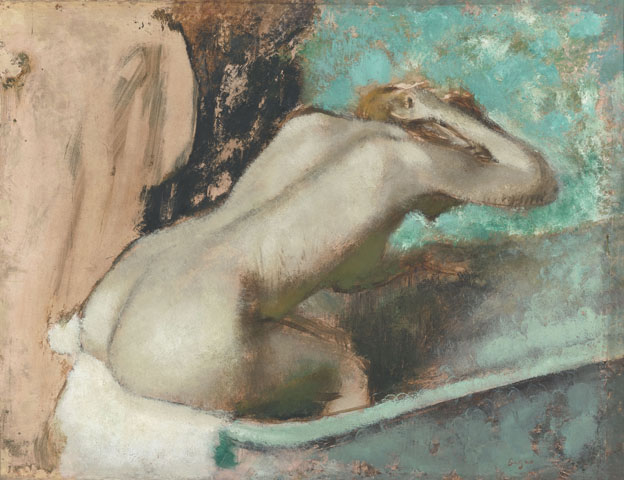Fr : version française / En: english version
mheu, Historical Museum of the Urban Environment
Woman seated on the edge of the bath sponging her neck
Hilaire-Germain Edgar de Gas known as Edgar Degas

c. 1880
51cm x 62cm
oil on canvas
Musée d'Orsay, Paris
© RMN (Musée d'Orsay) / Hervé Lewandowski
View this work in the exhibition Bathing
The work
There are many paintings, drawings and pastels by Degas showing a woman either in or seated on the edge of the bathtub, taking a bath or having just emerged from one. For Degas it was an opportunity to paint three-quarter and back views of the figure, draw nudes without showing the face and, like Bonnard after him, capture the play of light on the skin through its shimmering reflection in the water. But let us listen to Degas, whom history was to rank among the greatest artists of his time but also, as a man, a misogynist, reactionary and misanthrope: "Until now, the nude had always been shown in poses that presuppose an audience. But my women are unpretentious people... I show them without vanity or affectation, like animals cleaning themselves."
The artist
Born in Paris in 1834, Edgar Degas (a contraction of his real name, de Gas) belonged to a wealthy middle-class family of Neapolitan origin. He began formal studies in painting only in 1855, after studying law but, drawn by the painters of the Renaissance, left for Italy in 1856 where he traveled until 1860—initially staying with family in Naples and later moving on to Rome and Florence where he met Gustave Moreau. His early works, especially his portraits of family members, are neoclassical in style. But Degas' interest in intimate and risqué subjects such as cabaret, theatre and brothel scenes, his photography-inspired compositions (high- and low-angle), and long conversations with his friend Manet took him away from this style. From 1874 onwards, he kept company with the Impressionists without necessarily subscribing to their theories on light (he preferred artificial light) or working in the open air (his landscapes were painted only from memory). He is therefore an unclassifiable artist, who stopped painting in the early 1890s when he became virtually blind, but who continued to produce sculpture until his death in 1917.